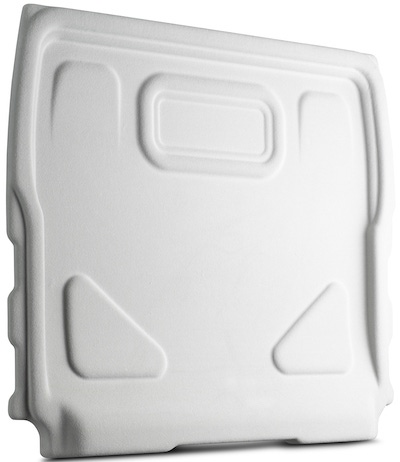Sabic’s Udmax fiber-reinforced thermoplastic composite unidirectional tape realizes a lightweight, cost-effective and recyclable vehicle panel.
April 9, 2019

Sabic announced a new, cutting-edge technology for producing lightweight, cost-effective and recyclable vehicle panels using its Udmax tape, a unidirectional, fiber-reinforced thermoplastic composite at the recent JEC World 2019 event. This innovative technology, which is designed to replace traditional panels made of metal and thermoset materials for interior and exterior automotive applications, will soon be commercialized in the bulkhead of a light commercial vehicle (LCV) produced in large scale for the global automotive market.
|
Produced using a highly efficient, one-shot process of lamination and low-pressure molding, the bulkhead featuring Udmax tape is 35% lighter and complies with ISO 27956 standard for securing cargo in delivery vehicles. |
The bulkhead was developed through international collaboration among Sabic; RLE International, an engineering services provider headquartered in the United Kingdom; AMA Composites, an Italian toolmaker; and Setex Textil GmbH, a weaver based in Germany.
Vehicle panels made with Udmax tape are said to combine strength and impact resistance with lightweight, which can result in mass reduction of interior panels of up to 35 percent in comparison to metal parts. In the case of exterior panels, the composite material can help reduce mass up to 50 percent. They are produced using a highly efficient, one-shot process of lamination and low-pressure molding.
“Our Udmax tapes offer the automotive industry a powerful solution to the ongoing challenges of reducing weight, lowering costs and improving sustainability,” said Hans Warmerdam, CEO and Chief Sales & Marketing Officer, Sabic FRT – a Sabic affiliate. “We’re confident that the light commercial vehicle’s bulkhead is the first of many structural applications where our innovative materials, combined with this novel processing approach, can help solve our customers’ challenges of achieving lighter weight without compromising safety, durability, and fuel or energy use. Through continued collaboration among this unique team of engineers, designers and technical experts in materials and in conversion processes, we intend to explore more ways to expand the adoption of our thermoplastic composite technology.”
The use of thermoplastic composites can lead to a significant reduction in mass in applications. In the case of the bulkhead, replacing a traditional metal component with the Udmax tape lamination within the part reduced mass by 35 percent in the application. Lower weight can also make the large bulkhead easier to handle, which could help to accelerate vehicle assembly.
This mass saving can be achieved without sacrificing the impact performance of the part, which is essential to protect occupants against injuries caused by shifting cargo. According to RLE International, the bulkhead complies with ISO 27956, the standard for securing cargo in delivery LCVs. The build-up of the process and the tensile strength of the Udmax are the main factors in optimizing the impact resistance of the bulkhead.
Compared to metallic or injection molded part of a conventional, multi-piece bulkhead, the new method – designed, developed and engineered by RLE International – can reduce tool costs by up to 80 percent compared to injection molding tools. This saving is due to the ability to replace an expensive, high- pressure tool with a lower-cost, low-pressure tool. Overall, the supplied cost of the LCV’s bulkhead can be 10 percent lower than the conventional metallic bulkhead that it replaces.
This technology also represents a revolutionary change in vehicle panel production by increasing efficiency and reducing complexity. With molding cycle times under two minutes, this streamlined process avoids sourcing and assembling multiple components, traditionally at different supplier locations, as well as secondary painting and trim operations.
A proprietary lamination featuring a core of extra-wide Udmax tape woven by Setex incorporates aesthetic finish a one-shot compression step. The process also allows varying the thickness of the panel in order to improve noise, vibration, and harshness (NHV) levels, helping to reduce noise in the vehicle. AMA Composites created the tool and molded the concept parts.
“Our new technology for producing panels using Udmax thermoplastic composite tape offers tremendous opportunities to the automotive industry,” said Mark Grix, head of Interior & Exterior Engineering for RLE International. “One example is the electric vehicle sector, where lower panel weight can extend driving range and lower-cost tooling can reduce capital investments for start-up companies. RLE International stands ready to assist automotive tiers in mastering this new process so they can leverage its advantages on behalf of their OEM customers.”
About the Author(s)
You May Also Like





